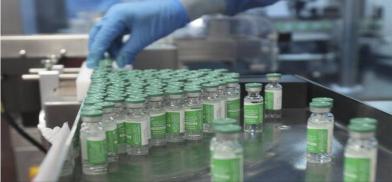India's resumption of vaccine supplies will ensure low-cost jabs for the world's poor
The impending resumption of exports thus is good news that will ensure low-cost jabs for the poor in Asia, Africa and Latin America and will also be beneficial for the South Asian neighborhood, especially countries like Afghanistan that are facing a humanitarian disaster while coping with the ravages of Covid-19, writes N Chandra Mohan for South Asia Monitor

After a brief hiatus, India has regained its mojo as a key player in the roll-out of vaccines for the raging Covid-19 pandemic that has afflicted an estimated 230 million people and caused nearly 5 million deaths around the world. About 825 million doses - about 15 percent of the 6 billion globally - have been administered in the country as of this week. Around 615 million people have received at least the first shot and 210 million the necessary second one - or 65 percent and 22 percent of India's eligible adult population of 944 million.
India’s prowess in producing vaccines is expected to take care of the needs of its citizens and also those of the South Asian neighborhood and low-income countries.
This was not the situation when the second wave of Covid-19 hit the country in April. India then was woefully short of vaccines, forcing it to curb exports and renege on contractual obligations. Despite having a head start, the country dithered on providing timely advance orders to Serum Institute of India and Bharat Biotech – whose vaccines were approved by the Drugs Controller General of India for emergency use authorization -- to scale up their production.
Serious shortages developed when the surging virus overwhelmed the public health system. The government then even talked to Pfizer and Moderna to bolster domestic vaccine supplies.
Besides lack of advance orders, the Pune-based USD 804 million SII - the world’s largest producer of low-cost vaccines - also faced serious shortages of raw materials to make vaccines, given the US ban on the export of 37 critical items including bags and filters under the Defense Production Act.
Ramp-up in vaccine output
With gradual improvement on this front since March, the company added more lines of production to step up output, even diverting a line meant for producing other vaccines. From two lines in April, this went up to five. SII thus has steadily scaled up monthly production from 65 million doses in May to current levels of 160 million and 200 million by October.
The flip in India’s vaccine fortunes has a lot to do with SII ramping up output in recent months. For a sense of perspective, it has supplied 720 million of the 822 million doses administered so far. The government has ordered 660 million doses to be delivered by December but indications are that SII’s supplies could be much more at 950 million.
It is this situation of potential plenty over the recent months that has sustained a weekly rolling seven-day average of 10 million daily doses administered in India as of September 21, according to Our World in Data. Prime Minister Narendra Modi confidently states that “India is now running the world’s largest vaccination campaign.
Constraints, empty promises
While arithmetic suggests that at the current pace of vaccination, it is virtually a done deal that India’s adult population will get at least the first jab by December, there is a need for caution. There are several constraints, including the logistical one of reaching the nooks and crannies of India's vast rural hinterland.
The state of public health facilities is uneven across the countryside, ranging from advanced in states like Kerala in the south to very weak in the poorest states of Uttar Pradesh and Bihar in the north. Further, if 4 million doctors and nurses are involved in the pre-Covid-19 immunization program, more are needed for a nationwide drive to administer Covid-19 vaccines.
“Politicians are in the habit of bluffing and their claims that India will be fully vaccinated by 2021 are far from real,” SII’s chairman, Dr. Cyrus Poonawalla, was quoted as saying at a prèss conference. At a different function, his son, CEO Adar Poonawalla, was far more diplomatic in stating that he did not want to guess: “Everyone in the pandemic I guess has been regretting making statements. So I do not want to guess”. All of this, however, does not prevent politicians from indulging in boosterism through 'vaccine festivals' and severely underestimating the complexity of the exercise of inoculating the adult population in a few months from now.
Nevertheless, with the turnaround in vaccine supplies, India is set to resume exports of vaccines for the world’s needy from October. This was discontinued in March-April after India supplied 66 million doses to 95-odd countries through outright grants, commercially or through COVAX, the vaccines pillar of the Access to Covid-19 Tools Accelerator, co-led by the Coalition for Epidemic Preparedness Innovations (CEPI), GAVI and the World Health Organisation.
The ban on exports impacted the ability of COVAX (Covid-19 Vaccines Global Access) to deliver 2 billion doses to low-income countries this year, forcing it to cut its target to 1.425 billion.
The impending resumption of exports thus is good news that will ensure low-cost jabs for the poor in Asia, Africa and Latin America. Africa is particularly keen for early resumption of India's vaccine exports on which they are very dependent. It will naturally benefit the South Asian neighborhood, especially Bangladesh, Sri Lanka and Nepal, and Afghanistan that is facing a humanitarian disaster while coping with the ravages of Covid-19.
(The writer is an economics and business commentator based in New Delhi, India. The views expressed are personal. He may be contacted at nchandramohan@rediffmail.com)









Post a Comment